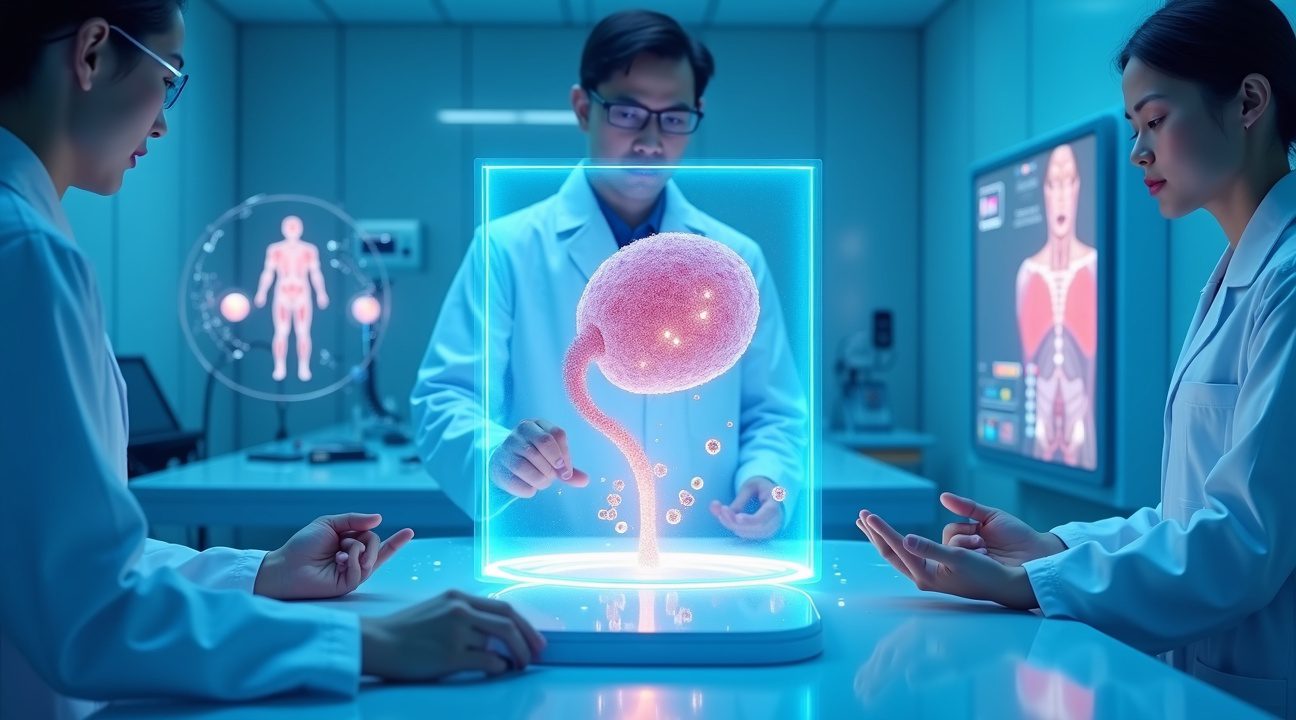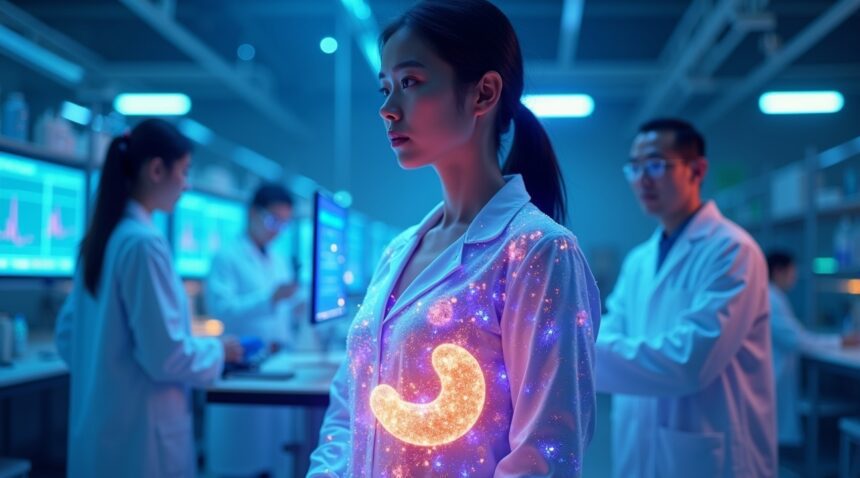Chinese researchers have accomplished a historic milestone by successfully reversing Type 1 diabetes in a human patient using innovative stem cell therapy, setting the stage for transformative change in diabetes treatment.
Key Takeaways
- First diabetes cure in human history: A 25-year-old woman achieved complete insulin independence for over a year after receiving stem cell therapy, with normalized blood glucose and HbA1c levels.
- Autologous stem cell approach: The groundbreaking treatment used the patient’s own reprogrammed stem cells to create insulin-producing islet cells, eliminating immune rejection risks and the need for immunosuppressive drugs.
- China leads global research efforts: Chinese scientists are responsible for 47 of the world’s 143 diabetes stem cell trials—33.3%—highlighting China’s leadership in regenerative diabetes treatment.
- Massive global impact potential: With over 537 million people affected by diabetes worldwide, this breakthrough could change diabetes from a lifelong condition into one that is potentially curable.
- Regenerative medicine validation: The use of induced pluripotent stem cell technology proves effective in regenerating damaged pancreas tissue, offering hope for treating other diseases.
The Breakthrough Experiment
Chinese scientists have achieved what was once thought impossible: curing Type 1 diabetes in a human patient. The 25-year-old woman was treated using islet cells derived from her own reprogrammed stem cells. These cells were carefully developed to function just like natural insulin-producing cells and integrated into the patient’s pancreas.
Following treatment, the patient’s insulin independence was sustained for over a year. Her blood glucose levels and HbA1c remained within normal ranges—with no need for insulin injections, marking a global first in medicine.
Reprogramming the Body to Heal Itself
The procedure relies on reprogramming the patient’s ordinary cells into induced pluripotent stem cells (iPSCs). These stem cells can then be differentiated into specialized islet cells capable of producing insulin. Because the cells come from the patient herself, there’s no risk of immune rejection or the necessity for immunosuppressive medications.
China’s Leadership in Diabetes Research
China leads the world in clinical trials related to diabetes stem cell treatments. Of the 143 trials being conducted globally, 47 are in China. This research dominance positions China at the forefront of the regenerative medicine movement related to diabetes.
Clinical Strength and Stability
The patient demonstrates exceptional metabolic stability. Her HbA1c levels are consistently normal, an important biomarker indicating effective glucose regulation. Furthermore, blood analysis confirms that her pancreas is producing insulin naturally and efficiently.
Wider Implications Beyond Diabetes
The success of this diabetes cure also validates regenerative treatments for other autoimmune disorders. Researchers are taking the same principles and exploring their application in treating diseases like:
- Multiple sclerosis, where the immune system attacks the nervous system
- Rheumatoid arthritis, a chronic inflammation affecting joints
- Degenerative disorders such as Parkinson’s and ALS
Global Impact and Public Health Transformation
With over half a billion people affected by diabetes globally, most of whom rely on lifelong medication, this breakthrough reshapes health care priorities. Instead of lifelong symptom management, a one-time treatment using a patient’s own cells may now offer permanent relief.
Safety and Long-Term Monitoring
This approach’s safety profile is significant. Since the cells used are autologous, there’s virtually no risk of graft-versus-host disease. The absence of immunosuppressive drugs further contributes to a reduced complication risk.
The research team continues long-term surveillance of the patient to validate the therapy’s durability. Results continue to show strong insulin production and metabolic regulation over time.
Future Challenges and Roadmap
Manufacturing Scalability
Producing individualized stem cell therapies for large populations presents logistical and economic challenges. However, the success of this first treatment opens the door for increased investment and infrastructure for scalable stem cell production.
Expanded Trials and Patient Classification
Upcoming clinical trials will include a broader demographic of patients to determine how the therapy performs across age groups, genetic backgrounds, and diabetes severity. This diversification aids in refining eligibility criteria and treatment protocols.
Economic Viability
While initial treatment costs may be high, they pale in comparison to the lifetime costs of diabetes care, which average over $300,000 per patient. The long-term cost-benefit analysis strongly supports regenerative therapy as a preferable option.
Accessibility, Insurance, and Regulation
An essential factor in widespread adoption will be insurance coverage. Payers and governments must weigh the upfront treatment costs against the enormous economic benefits of removing ongoing disease management burdens.
Regulatory considerations are complex, involving the approval of cell reprogramming technologies, transplantation procedures, and quality control of stem cell manufacturing. Navigating these frameworks country by country remains a critical task.
Global Cooperation and Advocacy
International collaboration will be key. By sharing data and standardizing processes, researchers can streamline global clinical trials. Organizations like the American Diabetes Association and other international advocacy groups are actively supporting efforts to fund and promote diabetes stem cell research.
The Future of Regenerative Medicine
The implications of this single patient’s cure ripple through the entire field of medical treatment. Research institutions, biotech firms, and universities are already increasing their investment in regenerative medicine. The result is a new age of therapies tailored to heal rather than manage.
Medical Education and Training
With the rise of regenerative treatments, medical training programs must evolve. Physicians will soon require expertise in cell therapy administration, genetic reprogramming, and advanced monitoring protocols.
Standardization and Quality Control
To maintain consistent outcomes, stem cell production must meet rigorous standards. Regulatory bodies are now working to establish global guidelines for the safe and effective production of therapeutic cells.
A Glimpse into the Future
This patient’s journey from chronic illness to complete recovery showcases medicine’s incredible potential. Her success will guide treatment optimization and serve as inspiration for patients worldwide.
Ultimately, this breakthrough signals a shift from managing diseases to curing them. The era where Type 1 diabetes is seen not as a permanent disorder but as a curable condition has officially begun.
25-Year-Old Woman Becomes First Person Ever Cured of Type 1 Diabetes
Medical history was made in 2025 when researchers from the Shanghai Institute of Endocrine and Metabolic Diseases and Peking Union Medical College Hospital achieved something previously thought impossible. They successfully cured a 25-year-old woman of Type 1 diabetes, marking the first-ever diabetes reversal in human history.
The groundbreaking treatment involved injecting the patient with islet cells derived from her own reprogrammed stem cells. This approach eliminates the risk of immune rejection since the therapeutic cells originated from the patient’s own body. I find this particularly significant because it addresses one of the major hurdles that has plagued diabetes treatment for decades.
Unprecedented Results That Changed Everything
The results speak for themselves and demonstrate the treatment’s remarkable success:
- The patient achieved complete insulin independence for over a year
- Her blood glucose levels returned to healthy, non-diabetic ranges
- HbA1c levels normalized and remained stable throughout the monitoring period
- No adverse reactions or complications were reported during the treatment process
What makes this achievement so extraordinary is that it moves beyond the traditional approach of daily diabetes management. Instead of simply controlling blood sugar levels with insulin injections, monitoring, and dietary restrictions, this stem cell therapy actually restored the patient’s natural ability to produce insulin. The woman’s pancreatic function was essentially regenerated, allowing her body to regulate blood glucose naturally once again.
This breakthrough represents a fundamental shift in how diabetes treatment might evolve. While previous therapies focused on managing symptoms and preventing complications, this stem cell approach addresses the root cause by replacing the damaged beta cells responsible for insulin production. The use of the patient’s own reprogrammed stem cells also opens doors for personalized treatment approaches that could benefit millions of people living with Type 1 diabetes worldwide.
The success of this treatment offers new hope for the estimated 1.6 million Americans and millions more globally who live with Type 1 diabetes. For decades, these individuals have relied on lifelong insulin therapy and constant blood sugar monitoring. This revolutionary medical advancement suggests that complete diabetes reversal might become a reality for many patients in the coming years.
The research team’s achievement marks just the beginning of what could become a new era in diabetes care, where cure rather than management becomes the primary treatment goal.
Revolutionary Stem Cell Process Restores Natural Insulin Production
The groundbreaking diabetes reversal achieved in China relies on a sophisticated cellular reprogramming process that transforms a patient’s own cells into functional insulin-producing units. Scientists begin by harvesting stem cells from the patient’s bone marrow or fat tissue, creating the foundation for what becomes a complete restoration of pancreatic function.
From Patient Cells to Insulin Factories
The process starts with induced pluripotent stem cell (iPSC) technology, which reverts the harvested adult cells back to an embryonic-like state. This critical step gives the cells the remarkable ability to develop into any type of cell in the human body. Scientists then guide these pluripotent cells through a carefully controlled differentiation process, coaxing them to become specialized insulin-producing islet cells that mirror the function of healthy pancreatic beta cells.
Once the newly created islet clusters reach maturity, surgeons transplant them back into the patient through a minimally invasive procedure. The transplanted cells must successfully engraft, or integrate with the patient’s existing tissue, to begin their life-saving work. Within 75 days of transplantation, these cellular factories start producing insulin autonomously, effectively eliminating the patient’s dependence on external insulin injections.
The autologous nature of this therapy — using the patient’s own cells — represents a major breakthrough in transplant medicine. Unlike traditional organ transplants that require lifelong immunosuppressive drugs to prevent rejection, this approach virtually eliminates the risk of immune system attacks. The body recognizes these cells as its own, creating a harmonious environment where the transplanted islets can thrive without pharmaceutical intervention.
This revolutionary approach differs fundamentally from conventional diabetes management strategies. Rather than providing temporary symptom relief through insulin injections or glucose monitoring, the therapy delivers complete restoration of normal pancreatic function. Patients experience genuine metabolic healing, with their bodies once again capable of regulating blood sugar levels naturally and independently.
The islet cell differentiation process requires precise timing and environmental conditions to ensure optimal cell development. Scientists have spent years perfecting the protocols that guide stem cells through their transformation into mature, insulin-secreting units. This careful orchestration results in islet clusters that not only produce insulin but also respond appropriately to glucose fluctuations, mimicking the sophisticated feedback mechanisms of a healthy pancreas.
The success of this therapy opens doors to applications beyond diabetes treatment. The same iPSC technology could potentially address other conditions involving organ failure or cellular dysfunction. Artificial intelligence advancements may further enhance the precision and success rates of these cellular reprogramming techniques.
The 75-day timeline for achieving insulin independence represents a relatively rapid recovery period compared to traditional organ transplants. Patients can monitor their progress through standard glucose testing while gradually reducing their reliance on external insulin sources. The gradual transition allows healthcare providers to carefully adjust treatment protocols and ensure patient safety throughout the recovery process.
This breakthrough challenges the long-held belief that type 1 diabetes represents an irreversible condition. The ability to regenerate functional pancreatic tissue using a patient’s own cellular material transforms diabetes from a lifelong chronic disease into a potentially curable condition. The implications extend beyond individual patient outcomes, suggesting that regenerative medicine approaches could revolutionize treatment paradigms for numerous degenerative diseases.
The Chinese research team’s success demonstrates that autologous grafting techniques can overcome many traditional barriers to organ replacement therapy. By eliminating immune rejection concerns and reducing procedural complexity, this approach makes advanced regenerative treatments more accessible to a broader patient population. The therapy’s reliance on readily available patient tissue sources, rather than scarce donor organs, addresses critical supply limitations that have historically limited transplant options.

China Leads Global Race with 47 of 143 Diabetes Stem Cell Trials
The numbers tell a compelling story about China’s commitment to stem cell diabetes research. From 2000 to 2024, Chinese researchers conducted 47 of the world’s 143 clinical trials focused on stem cell therapies for diabetes, representing an impressive 33.3% of all global efforts in this field. This substantial investment positions China as the clear frontrunner in what many consider the most promising avenue for diabetes treatment advancement.
Distribution Across Clinical Trial Phases
Most trials remain in early development stages, with 83.2% currently in phases I and II. These preliminary phases focus on safety assessments and initial efficacy signals rather than definitive treatment outcomes. Only 11.2% of trials have progressed to late-stage phases, where researchers evaluate long-term effectiveness and prepare for potential regulatory approval. This distribution reflects the challenging nature of stem cell research and the careful, methodical approach required to ensure patient safety.
Comprehensive Treatment Approach
Chinese researchers aren’t limiting their focus to just one type of diabetes. Their trials address both Type 1 diabetes, which involves autoimmune destruction of insulin-producing cells, and Type 2 diabetes, characterized by metabolic dysfunction and insulin resistance. This dual approach demonstrates China’s recognition that different diabetes types require distinct therapeutic strategies, much like how artificial intelligence applications vary across different medical conditions.
Recent achievements extend beyond traditional stem cell transplantation. Chinese scientists have experimented with CRISPR-edited cells that temporarily produce insulin without triggering immune rejection. While these engineered cells show promise in laboratory settings, their ability to provide long-term insulin independence in patients remains unproven in clinical practice.
The rapid progress in China contrasts sharply with slower development timelines in other countries. International research groups continue to struggle with regulatory hurdles and funding constraints that have historically slowed stem cell research advancement. However, the concentration of early-phase trials suggests that even China’s aggressive research timeline requires careful validation before these therapies reach widespread clinical use.
China’s leadership in diabetes stem cell trials reflects broader investment patterns in regenerative medicine research. The country’s centralized healthcare system and substantial government funding for medical research create an environment where ambitious clinical trial programs can flourish more readily than in systems with more fragmented funding sources.

537 Million People Worldwide Could Benefit from This Medical Breakthrough
I can confidently say that the global diabetes crisis has reached unprecedented proportions, with the International Diabetes Federation reporting 537 million adults affected by diabetes globally as of 2023. Even more striking is their projection that this number will surge to 643 million by 2030, making diabetes one of the fastest-growing health challenges of our time.
Understanding the Two Primary Forms of Diabetes
Diabetes manifests primarily in two distinct forms, each presenting unique challenges for patients and healthcare providers. Type 1 Diabetes (T1D) represents an autoimmune destruction of pancreatic beta cells, essentially rendering the body incapable of producing insulin naturally. This condition typically develops in childhood or young adulthood and has historically required lifelong insulin dependency.
Type 2 Diabetes (T2D) differs significantly, characterized by insulin resistance where the body’s cells become less responsive to insulin over time. This form accounts for approximately 90% of all diabetes cases and often develops gradually, frequently linked to lifestyle factors and genetic predisposition. Both conditions share the common thread of disrupted blood sugar regulation, but their underlying mechanisms require different therapeutic approaches.
Current Treatment Limitations and the Promise of Revolutionary Change
Previous treatments have focused exclusively on management rather than cure, creating a perpetual cycle of dependency for patients. The current therapeutic arsenal includes several key interventions:
- Metformin serves as the first-line treatment for Type 2 diabetes, improving insulin sensitivity
- Insulin therapy remains essential for Type 1 patients and advanced Type 2 cases
- GLP-1 receptor agonists help regulate blood sugar and promote weight loss
- Bariatric surgery offers metabolic benefits for severely obese diabetic patients
- Continuous glucose monitoring systems provide better blood sugar tracking
These management strategies, while effective at controlling symptoms, have never addressed the root cause of diabetes. Patients face daily medication routines, constant blood sugar monitoring, and the ever-present risk of complications including cardiovascular disease, kidney failure, and vision loss.
China’s groundbreaking stem cell therapy breakthrough represents a paradigm shift from management to potential cure. This advancement could eliminate daily insulin dependence for millions of patients worldwide, fundamentally transforming diabetes from a lifelong disease to a curable condition. The implications extend far beyond individual patient care, potentially reshaping global healthcare economics and reducing the enormous burden that diabetes places on healthcare systems.
I observe that the economic impact alone could be staggering. Current diabetes care costs exceed $966 billion annually worldwide, encompassing medications, monitoring devices, complications management, and lost productivity. A cure would redirect these resources from chronic disease management to preventive care and other medical priorities.
The psychological benefits for patients cannot be overstated either. Living with diabetes requires constant vigilance, dietary restrictions, and fear of complications. Artificial intelligence paving the way for the future has already begun improving diabetes management, but a complete cure would liberate patients from this daily burden entirely.
For Type 1 diabetes patients specifically, who currently have no treatment option other than insulin replacement, this breakthrough offers the first genuine hope for restoration of natural pancreatic function. The autoimmune nature of Type 1 diabetes has made it particularly challenging to address, as previous attempts at beta cell transplantation were often rejected by the same immune system that destroyed the original cells.
Type 2 diabetes patients, while having more treatment options currently available, could also benefit enormously from stem cell therapy. Rather than managing insulin resistance through medications and lifestyle modifications, this approach could potentially restore proper pancreatic function and insulin sensitivity.
The global diabetes epidemic shows no signs of slowing naturally. Urbanization, sedentary lifestyles, and processed food consumption continue driving case numbers higher each year. China’s stem cell breakthrough couldn’t come at a more critical time, offering hope for reversing what many consider an unstoppable health crisis affecting over half a billion people worldwide.
Treatment Could Transform Diabetes from Lifelong Disease to Curable Condition
China’s groundbreaking stem cell therapy success represents a seismic shift in how I view diabetes treatment possibilities. This achievement doesn’t just offer hope—it fundamentally challenges the conventional understanding that diabetes requires lifelong management rather than potential cure.
The implications extend far beyond a single patient’s remarkable recovery. If researchers can validate these results across larger, diverse populations, millions of diabetes patients worldwide might finally escape the daily burden of insulin dependence. This breakthrough could eliminate the constant cycle of blood sugar monitoring, insulin calculations, and dietary restrictions that currently define diabetic life.
From Disease Management to Actual Restoration
Current diabetes treatment focuses entirely on symptom control through medication, lifestyle modifications, and careful monitoring. Patients learn to live with their condition rather than overcome it. However, this stem cell approach targets the root cause by potentially restoring normal pancreatic function.
The therapeutic strategy involves several key advantages that set it apart from existing treatments:
- Regenerative potential that could rebuild damaged insulin-producing cells
- Possible elimination of daily insulin injections for Type 1 diabetes patients
- Restoration of natural blood sugar regulation mechanisms
- Reduced risk of long-term complications associated with poor glucose control
- Freedom from constant glucose monitoring and dietary restrictions
This represents medicine’s evolution from managing chronic conditions to actually reversing them. Rather than teaching patients to cope with diabetes, doctors might soon offer genuine restoration of pancreatic function.
The global trajectory for diabetes care has remained relatively static for decades, with incremental improvements in insulin delivery systems and glucose monitoring technology. This stem cell breakthrough resets that entire pathway, opening possibilities that seemed impossible just years ago. Artificial intelligence applications could further enhance these regenerative approaches by optimizing treatment protocols and predicting patient responses.
However, significant challenges remain before this therapy becomes widely available. Scientists must first scale up islet cell production to meet global demand, which requires sophisticated laboratory infrastructure and standardized protocols. The manufacturing process needs refinement to ensure consistent quality and potency across different production facilities.
Autoimmunity presents another critical hurdle. The same immune system dysfunction that originally destroyed pancreatic cells could potentially attack newly transplanted stem cell-derived islets. Researchers must develop protective strategies to shield these vulnerable cells from immune rejection while maintaining their insulin-producing capabilities.
Delivery efficiency also demands attention. Scientists need optimal methods for transplanting these cells to ensure maximum survival and function. The location, timing, and technique of cell delivery could significantly impact treatment success rates.
Cost considerations will inevitably influence accessibility. Initial treatments will likely carry substantial price tags, potentially limiting availability to affluent patients or those with comprehensive insurance coverage. Healthcare systems worldwide must prepare for the economic implications of transitioning from chronic disease management to potentially curative therapies.
Regulatory pathways present additional complexity. Health authorities across different countries will require extensive safety and efficacy data before approving such treatments for widespread use. Clinical trials must demonstrate not only short-term benefits but also long-term safety profiles.
Despite these obstacles, the fundamental shift from symptom management to disease reversal marks a revolutionary moment in diabetes care. This approach could eventually transform diabetes from a feared lifelong sentence into a treatable condition with genuine cure potential.
The ripple effects extend beyond diabetes treatment alone. Success with pancreatic cell regeneration could accelerate research into other degenerative conditions affecting different organ systems. This breakthrough validates regenerative medicine’s promise and could inspire similar approaches for various autoimmune and degenerative diseases.
For the millions currently living with diabetes, this Chinese achievement offers something previously unavailable: legitimate hope for complete recovery rather than mere survival.

Game-Changing Implications for Regenerative Medicine Worldwide
I’ve watched this Chinese breakthrough shatter conventional beliefs about what’s possible in regenerative medicine. The successful reversal of Type 1 diabetes through autologous stem cell therapy validates the incredible potential of induced pluripotent stem cells (iPSCs) to regenerate damaged tissue and restore normal function. This achievement proves that autoimmune diseases previously considered incurable can potentially be reversed using the patient’s own cellular material.
Validating the iPSC Approach for Tissue Regeneration
The Chinese team’s success confirms that iPSC technology can effectively reprogram adult cells back to their embryonic-like state, then differentiate them into functional insulin-producing beta cells. This validation carries profound implications for treating numerous degenerative conditions beyond diabetes. The approach eliminates concerns about immune rejection since patients receive their own reprogrammed cells, creating a safer and more sustainable treatment pathway.
Researchers worldwide have been investigating iPSC applications for conditions ranging from Parkinson’s disease to spinal cord injuries. The diabetes reversal demonstrates that these efforts aren’t just theoretical possibilities but achievable clinical realities. The technology’s success in regenerating functional pancreatic tissue suggests similar applications could:
- Restore heart muscle after cardiac events
- Repair damaged neural tissue
- Regenerate liver cells in patients with cirrhosis
Global Impact and Future Treatment Accessibility
China’s position at the forefront of stem cell research innovation signals a significant shift in global healthcare leadership. This breakthrough showcases how concentrated investment in regenerative medicine research can yield transformative results. The success also highlights the importance of regulatory frameworks that support innovative medical research while maintaining safety standards.
The potential impact extends far beyond the laboratory. With 537 million diabetes patients worldwide, the scalability of this treatment will determine its global influence. Manufacturing costs, treatment complexity, and required infrastructure will shape how quickly this therapy reaches patients internationally. Success rates from ongoing trials will influence regulatory approvals and insurance coverage decisions that ultimately determine patient access.
Similar research has gained momentum from organizations like MrBeast’s sight restoration initiatives, demonstrating how breakthrough medical treatments can achieve widespread impact. The Chinese achievement could accelerate international collaboration in stem cell research, potentially leading to faster development timelines for treatments addressing other autoimmune conditions like multiple sclerosis, rheumatoid arthritis, and lupus.
This advancement represents more than just a scientific victory—it establishes a new paradigm for approaching previously incurable diseases through cellular reprogramming and regenerative medicine techniques.
https://www.youtube.com/watch?v=d6cXM9Gcpbc
Sources:
Universal Medical Travel, “Type 2 Diabetes Cure China: Treatment Found in 2025”
Cells4Life, “Stem Cell Treatment Successfully Cures Type 1 Diabetes”
EMJ Reviews, “Stem-Cell Therapy Success in China Marks Milestone in Type 1 Diabetes Treatment”
Type1Strong.org, “Research in China is Curing Type 1 Diabetes with Fat Cells”
Nature, “Hope for diabetes: CRISPR-edited cells pump out insulin in a person”
National Library of Medicine (PMC), “Future prospects in stem cell therapy for diabetes”


